Books
Compiled by Martin Willey
Sidney, John and Alfred Pemberton were second hand booksellers who started a publishing company, World Distributors (Manchester) Ltd in the 1950s. The publisher specialised in hard-cover children's annuals, licensed from popular TV shows. The annuals were published in August, and promoted strongly for Christmas presents. Often they had the following year's date (so the 1975 Star Trek annual was published in August 1974); the Space: 1999 titles had no cover dates. In 1980 the company became World International Ltd, but the tradition of annuals was in sharp decline. By 1990 the company was defunct. Their assets were taken over in 1999 by Danish children's publisher Egmont. In 1975 and 1976 World Distributors also produced colouring and activity books.
The contents comprised text and comic strip stories, various puzzles & games (a board type game, spot the difference between photos, quizzes), articles on space facts, biographies of cast, cartoons (& from 1976 on, photos with humorous speech bubbles added). They were well illustrated with colour photos. The stories were routine space adventure, but exciting. The articles were well researched and entertaining: the background articles on Moonbase life in the first annual were especially good.
The contents of first 4 Space 1999 annuals were written by Angus P Allen (who also wrote the stories for Look-In comic). The two-colour comic strips were drawn by John Burns in 1975 (he also drew for the Look-In comic), by Martin Asbury in 1976 (artist of the Garth strip and storyboard artist on the films Greystoke, Legend, Indiana Jones and the Last Crusade, Alien 3) and by Walt Howarth in 1977 and 1978 (Howarth also did the Hope jigsaw puzzles). The cover art on three of the five annuals was by Edgar Hodges (an artist who worked for World Distributors).
All published in August of year.
| 1975
(SBN 7235 0329 X; pp64; £1.00) 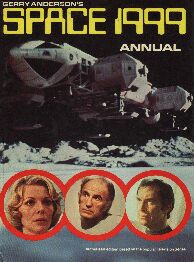
|
20 x 27.5 cm, cover photo of launching Eagle, with insets of Koenig, Helena, Victor | Stories
Strips: (John M. Burns)
|
| 1976
(SBN 7235 0329 6; pp78; £1.25) 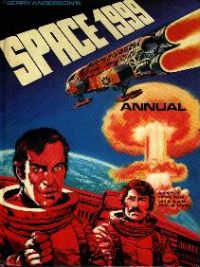
|
22 x 29 cm, cover art of Koenig, Paul, Eagle & mushroom explosion (Walt Howarth) | Stories:
Strips: (Martin Asbury)
|
| 1977
(SBN 7235 0431 8; pp62 ; £1.35) 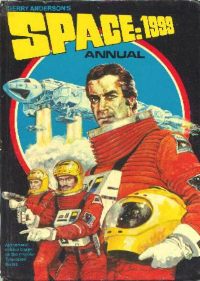
|
20 x 27.5 cm, cover art of Koenig, Eagle & 2 astronauts (Walt Howarth) | Stories:
Strips: (Walt Howarth)
|
| 1978
(SBN 7235 6504 X ; pp62 ; £1.50 ) 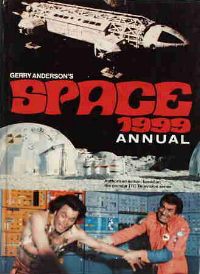 |
20 x 27.5 cm, cover photo of Eagle, BOW domes, Koenig fighting alien (contents Year 2) | Stories:
Strips: (Walt Howarth)
|
| 1979
(SBN 7235 6550 3; pp62 ; £1.75 ; published by World Distributors/ Whitman) 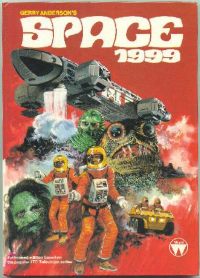 |
20 x 27.5 cm, cover art of Eagle, astronauts, 3 space animals (art by Edgar Hodges) | The contents reprinted the Charlton colour comic strips:
|
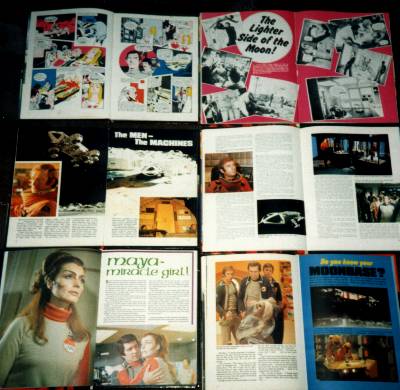
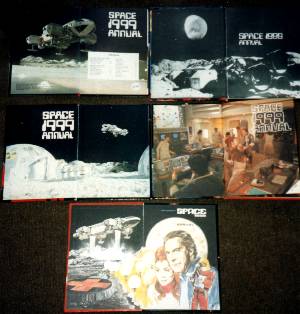
US,UK Nov 1976
ISBN 0 345 25265-9-195 ; pp259 with 32 page b/w photo section
US $1.95, UK 85p (the US edition was widely distributed in the UK)
10.5 x 18 cm, cover design of spotlight, boom & camera; left is strip of publicity photos.
Behind the scenes conversations with Year 2 cast & crew, with chapters on direction, make up, design, scripts, music, casting, effects, dubbing & cutting, plus profiles of Anderson, Freiberger, cast. Three appendices: 'Metamorph' call sheet, shooting schedule, synopses of Year 1 episodes & 8 of Year 2 (the book was finished in May 1976). Good behind-the-scenes information with some revealing quotes gathered by the journalist Tim Heald.
Heald recounts in the book how Keith Shackleton, head of Gerry Anderson Marketing, approached Hunter Davies, author of the authorised biography of The Beatles, to write the book. Davies had just been appointed editor of the Sunday Times magazine, so the job went instead to Heald, an old colleague of Davies. Heald had been feature writer for the Daily Express until 1972, and wrote book and travel features. His books included authorised biographies of Prince Philip (1991) and Princess Margaret (2007), plus crime fiction, several titles of which were adapted for television. He died in 2016.
Revised version released as All Sections Alpha: The Making of Space: 1999 (Anderson Entertainment, 2025).
From a video interview with Keith Shackleton, released in 2023:
I heard a buzz that a book in the States called The Making of Star Trek had sold four million copies, which is a lot of copies. I got hold of a guy called Tim Heald, who writes for the Telegraph and the Radio Times. He came down to the studio, a splendid lunch and a chat, and we got him to write a synopsis for a book called The Making of Space 1999. I sold this on a one page letter to a company in New York called Ballantines, who had published the Star Trek book. We got a contract, and Tim to write the book, we got Reg Hill to design the cover, and we went to press. We didn't sell 4 million copies, we sold 40 thousand. I would say it was for 2 reasons. The design of the cover was wrong, but the series didn't take off in the States. It should have done, it had the makings of another Star Trek.
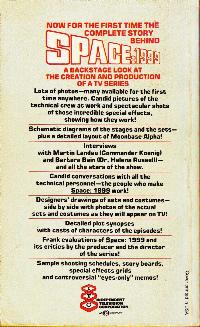
Contents
US 1976
96 pages. Introduction & 5 text stories with comic type illustrations, adapted from art for the Charlton b/w comics. Pages are unnumbered. Each story has art from multiple comics; just some main sources are indicated.
In the 1970s, publishers were able to market to US schools via book clubs. This title was produced by Charlton Press for Xerox. Other examples include Reader's Digest Science Fiction Top Picks, Dynamite magazine, TV's Fabulous Faces and Senior Weekly Reader.
Paperback cover shows colour art of Moonbase with a foreground astronaut (in white spacesuit) pointing to it (from "A Lonely Emperor", Charlton Vol 2 No 4, by Carlos Pino). Rear cover shows Eagle blasting through space.
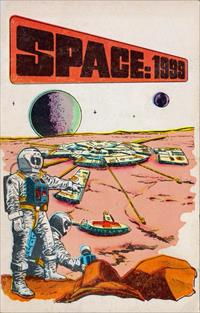
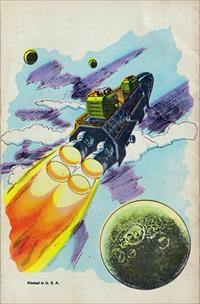
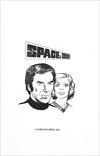
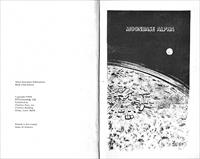
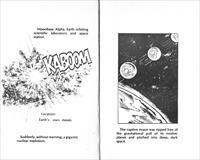
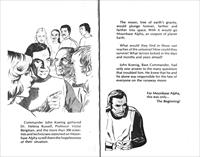
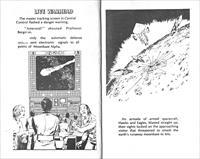
US 1977, 59c
32 pages & softcard cover, 18 x 26 cm. The cover shows the Metamorph Eagle, and Koenig, Helena, and Alan peering over a rock. Two (year 2) stories by Mary A Mintzer ("The Return Of the Metamorph", "Queen Brain"), colour illustrations by Frank Bolle. Very crude & juvenile.
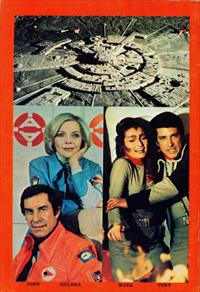
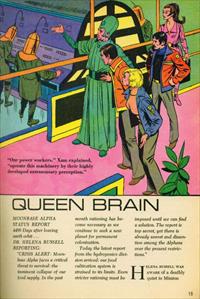
US October 1977, $9.95
80 pages (single sided, including 5 fold out pages) in loose leaf red vinyl binder (25.5 x 29 x 4 cm). Cover embossed with Alpha insignia.
Compiled & written by David Hirsch, with blueprints by Geoffrey Mandel & David McConnell, & costume art by Anthony Fredrickson.
Mandel, no relation to ITC's Abe Mandell, and Fredrickson had been involved in Star Trek publishing, notably Star Fleet Medical Reference Manual, first as a fanzine then professionally published by Ballantine October 1977. Both joined the staff of the series Star Trek Deep Space Nine (1993-1999) and would work as graphic artists on several Star Trek series, as well as other series. Mandel worked on Mad Men, Agents of S.H.I.E.L.D. and Veep (personal website). Fredrickson died in 2016.
Hirsch was a writer for Starlog who would later be involved in the creation of the Super Space Theatre compilation movies, and write the Space: 1999 books To Everything That Might Have Been (2022) and Maybe There - The Lost Stories from Space: 1999 (2022)
The Technical Notebook contains blueprints of Alpha layout, Year 2 principle sets (varying accuracy), communications post, comlock, stun gun, laser cannon, uniform & spacesuits. Short profiles of main characters, timeline before & after Breakaway (inaccurate), synopses of all episodes. B/w photos.
It was intended to publish supplements, but the Notebook had poor sales. An entertaining good quality item with some mostly minor inaccuracies. One thing notably missing were Eagle blueprints. Mandel had previously done a set for Starlog magazine (issue 7, dated August 1977), but they were not included. In Starlog 32 (March 1980) he did Hawk blueprints (p52-53). In 2023 Mandel sold Eagle and Hawk posters via etsy.
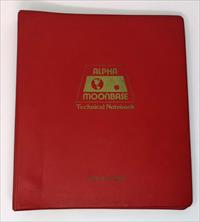
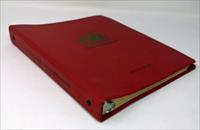
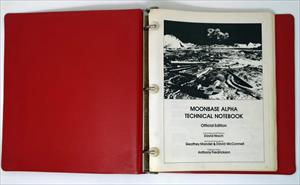
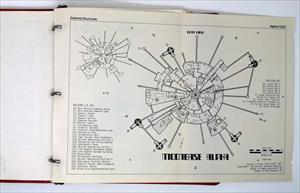
Online:
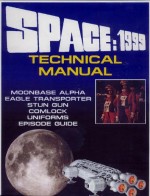
Cover of fan reprint, which included the Eagle blueprint from Starlog.
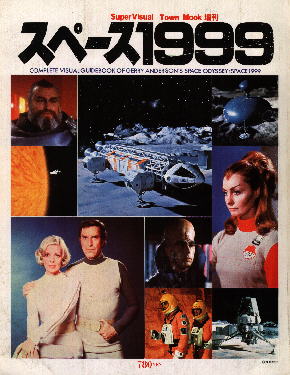
Japan, 1981, 780 Yen
20.5 x 25.5 cm. pp122 (Japanese text)
48 colour pages, crammed with colour photos (superb in quality & selection), covering in sections the Moonbase, characters, Eagles, alien ships, aliens, & 2 "filmstories", telling Last Enemy & Metamorph in 78 photos each.
56 b/w pages, crammed with dark poor quality photos, give "storyguides" for every episode (about a page each), plus an "Encyclopedia", with blueprints of base, Eagle, & Main Mission & Command Centre (slightly redrawn from the Starlog and Technical Notebook prints), profiles of cast & crew, the series background, & selected merchandise.
Probably the best item of merchandise produced, with superb photo coverage of almost every aspect of the series.
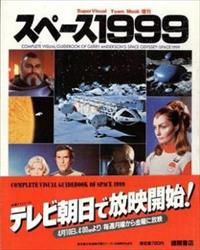
This version has an "tasuki", a paper slip that is folded outside the cover (here in red). In Japanese publishing the tasuki fulfils the same purpose as the text on the back cover of a western book, describing the contents, publisher and price (rarely repeated on the back or front cover). It is often discarded or lost after purchase, and the rarity makes them collectible. In English the tasuki is often mistakenly called an "obi".
UK, April 21st 1994. £9.99
ISBN 1 85283 393 9
96 pages, softcover.
Glossy guide to the two series, illustrated by many good, sometimes unusual photos in colour and black and white. Includes short and sketchy chapters on production details, characters and scenario, culled from publicity material and other sources (such as Heald's "Making Of Space 1999" book), plus an episode listing.
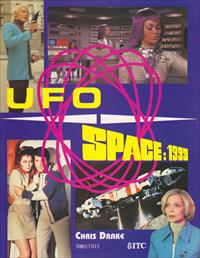
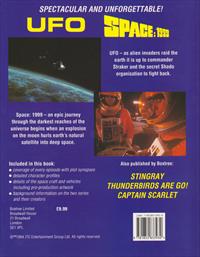
Italy, November 2000. L. 36000 €18.60
128 pages, hardcover.
Italian version of above book. Fanucci also published compilations of Gianni Padoan novels. The glossy pages have many more photos than the UK original. There is an additional "technical section" for each series, the four page Space 1999 section consisting of plans of the Moonbase and Eagle, and a colour cut-away of the Eagle, all by Roberto Baldassari. There is a new epilogue, about Message From Moonbase Alpha, with the complete script (in Italian).
The Message epilogue was reprinted in Fanucci's Spazio 1999: L'ultimo tramonto by Gianni Padoan (2001).
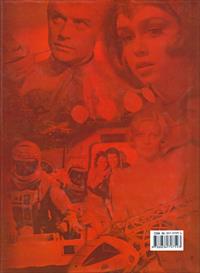
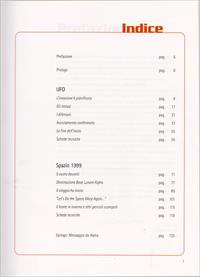
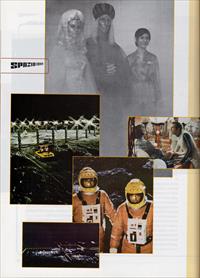
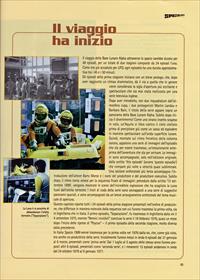
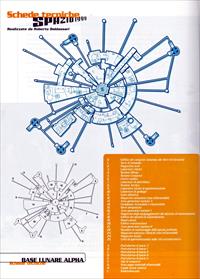
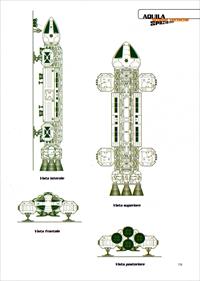
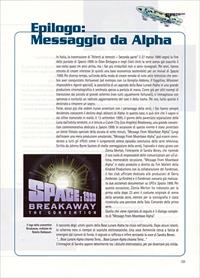
France, first edition June 1993 (1500 copies, 72 pages), second edition September 1996 (1500 copies, 125 pages). 70FF
ISBN 2-87795-087-5
Card cover, 11.5cm x 21cm.
In the series Le Guide Du Telefan, a series of pocket guides to cult television series written by fans but published professionally. In French with black and white photo illustrations. The colour cover shows Koenig and Helena cowering in front of the computer. The subtitle means "The Epic Of Whiteness", a reference to the symbolism of the series.
A useful, fairly comprehensive and mostly accurate guide to the series with articles on symbolism, profiles of cast and crew, episode guide with notes, clubs and merchandise. The episode guide has original air dates (in the UK and France), credits, short plot summary and production notes and observations (less extensively for the second series). A glossary ("Le petit Alpha illustré", after French dictionaries), contains entries from "Aigle" (Eagle) to "Zantor", via "Kitsch", "Inconnue" (unknown) and "X" (which begins: "Question for 100 francs: do Koenig and Russell sleep together?").
Second edition table of contents:
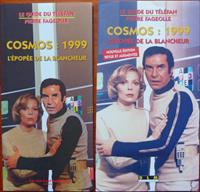
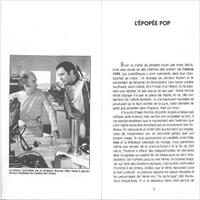
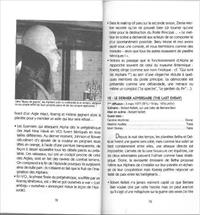
Thanks to Nicolas Lemarignier
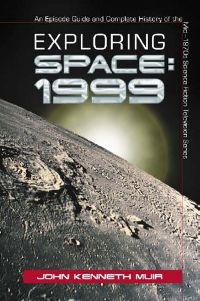
Hardback: US October 1997 $36.50 ISBN 0-7864-0165-6
Paperback: US February 2005 $24.95 ISBN 0-7864-2276-9
232 pages
Subtitled: "An Episode Guide and Complete History Of The Mid 1970s Science Fiction Television Series". Originally issued as a hardback with plain library binding and a print run of 1000, it was reissued in 2005 as a paperback edition with a photographic cover (an astronomy photo of the real moon, not a series photo).
History, episode guide including critical commentary, interview with Catherine Schell, summary of criticism (focusing on Asimov's criticisms and the Star Trek feud), fans and collectibles, short bibliography, index.
As the wordy subtitle suggests, Muir adopts an academic approach based around an episode guide and placing the series in the context of other science fiction television. It is sparsely illustrated with black and white photos (only five from the series, with more of cast members in other films) and with two pieces of line art from John Semprit. Muir has few background stories (Fageolle's Guide Du Telefan is a superior reference work in this respect). As a result, while the book is very accurate as far as on-screen information goes, it is guilty of some (minor) false assumptions and technical inaccuracies. While it makes reference to visual style and story continuity, these aspects are not greatly explored. Instead the approach is thematic, focused on plots, characterisation and ideas. It is more lightweight than the symbolism and philosophy in Fageolle's book, but nevertheless the episode analysis is well thought out and expressed, neither hagiography or damning, with a strong preference for the serious eerie mysteries of Year One. The focus on drawing similarities with other television science fiction, especially Star Trek, is a rewarding angle. The hypothesis is that, just as Space: 1999 was influenced by the original Star Trek, it provided themes and ideas used in the 1980s series Star Trek: The Next Generation. Thorough and impressive.
US 1999; 25 copies ($30 each)
104 pages black and white with colour covers; spiral bound.
A thorough survey of the Space: 1999 toys and books produced, almost all illustrated with black and white photos, short description and manufacturer. Includes a price guide and some prototype toys from dealer catalogues. The front cover is based on the original packaging design for Azrak-Hamway's range of Space: 1999 toys.
Photos thanks to Gordon Moriguchi.
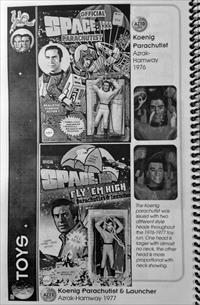
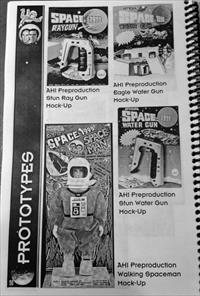
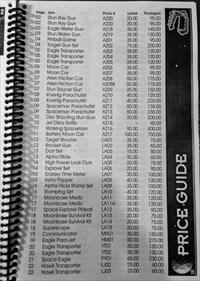
Copyright Martin Willey